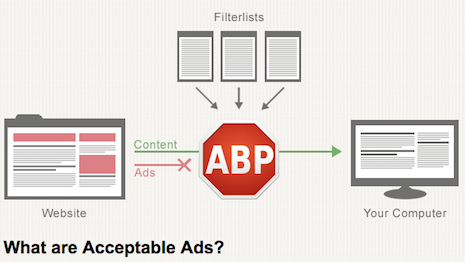By Tal Schwartz
AdBlock Plus, the Internet’s horse blinders, last week made an interesting announcement: it is entering the business of serving ads.
Not incredibly intuitive, huh?
AdBlock Plus is launching a marketplace for real-time bidding on digital ad inventory.
Advertisements that are deemed “acceptable ads” will be rendered on an AdBlock Plus user’s screen in the place of whatever ad was blocked originally.
The move is an attempt to create an ecosystem of publishers and advertisers that can compete for ad placement voted on by consumers.
If the ad that I am served beside my Cosmo gossip column is intrusive or irrelevant, I can now vote to replace the advertisement with a more suitable one.
This is a substantial departure from the traditional ad serving system of more dollars equals more abrasive ads. And the consumer pushback that has already mounted just from this past morning is a testament to this shift.
But why are we, the readers, upset?
Unrealistic expectations of the Web
The average keyboard crusader takes the Internet for granted.
I click on a video of a panda on a slide with the expectation of receiving immediate gratification. But the Internet operates on a value exchange.
I serve you content, but you have to let me target you with advertisements. It is the same reason your neighbor still gets a roll of coupons in the free Sunday paper.
And in principle, there is nothing wrong with this system.
Retargeting has the potential to serve me beautifully curated content that is tailored specifically for me in this moment.
However, this is clearly not always the case.
Shotgun advertising tactics and spam-esque banner ads still clutter your screen unintelligently. And so we slam down our ice-coffees in frustration and lean over to the girl sitting next to us in the cafe to say, “What’s the name of that ad blocker plugin everyone uses?”
But what do we do now?
Even AdBlock Plus, that bastion of the online and mobile reader, has turned its big red stop sign palm away from us as if to say, “Talk to the hand because our wallets aren’t listening.”
But is this really the case?
Take Facebook, for example. In the always-evolving News Feed we get served an endless number of advertisements per scroll. But do we delete our accounts or slam down our iced beverages? No. And why is that?
Because Facebook humanizes the ads it serves us. It comes clad in friendly window dressing to look like any other cool account to which you subscribe. It asks you nice questions such as, “Are you interested in the Toronto Marathon?” before slapping you across the face with the incredibly photogenic guy meme. It inserts advertorial content seamlessly into our reading lists with a sleek “sponsored” sub-header above it. No clutter, no monkey business.
Facebook sponsored content succeeds because it works for our acceptance. And the result? Publishers are happy because they can drive sponsorship revenue. Advertisers are happy because they get seamless distribution. I am happy because I get relevant, non-invasive, high-quality sponsored content.
So why not apply this system to the rest of the Web?
AdBlock Plus may at first seem like it is abandoning its principles. But in reality, it is exposing an ugly existential threat to the publishing business.
We no longer like consuming content on our publisher’s digital properties because it is not sexy. And so publishers, the guys we love to consume on Facebook, are hung out to dry because we hate the ad-heavy experience we are handed on their distribution channels.
AdBlock Plus has the opportunity to rebuild trust between publishers and consumers by empowering the reader.
I can now vote on what content I want to see, how it is delivered and at what frequency.
I essentially am handing over a rulebook to the advertising community.
ADBLOCK PLUS IS trying to put the human back in the driver’s seat.
A platform that gives the consumer a voice in determining what is and is not acceptable could just be the solution that publishers are craving.
And who knows, maybe your neighbors will not be the only ones collecting coupons in their Sunday paper.
 Tal Schwartz is CEO of Thinkwire
Tal Schwartz is CEO of Thinkwire
Tal Schwartz is CEO of Thinkwire, Toronto. Reach him at [email protected].
{"ct":"Row8ySZiRdT8VGseAi8j+GdEevOlcWBoqcn11vaLkiNsAMrJJVCpY9EaZNfPR86Vc7ExatlbeP58UrF+HdQjIBjdlQ84VcvnUwkumLXtDzEUSqnENw6EaAgJFzgkDBBXaoLGpaztpzPMID16cCGSEHhS79Ks6efZ03ttZgaWdrPRWKQgTV+Mch6czo3QTsOXdTM7Gc\/HKD++t72u3gVIlFeXfLj+VYLBqOnGd5UfOBpJhCBpKSyN0vXbtLw0hv5Z0GDy+5KFbB6GON+aLaNX8pceHwBM\/XBQ6jV2InvPvLHLICUV5CHg4wxtgI7doQw1CHB0\/XPKLTQ5cLtRaRhpAMnFZbPUV9amwQE\/SXRbReYGxQU\/Dno2myu+dKv3whEqeB3B4E9uzsaAtVUg6kPGGA3k2y+elzEWeFTpr8W2g1r5zL5yEiLOtvLE9zaZqdCAsdAK2\/dcEj4pzpaLYJ\/zBbU4h4wO0Y889D60F6ZNgu1feap\/XMzlrbvdJUslWbm2aJjhgX90V7fpgar5Gk\/DAZQJI4xgWd9LOJCsWle5\/fMyKvhByKqssKrjvo9jf3WkXDjJe+eT4yErekyXFnm2ku2X3dB7y\/B1SBP6ikI56CiqZrQM\/Bo9Ag+2GMpFneIRTMZzWIWgTOATjSYvqoD4O+u22E1bD8hisvZ32JaGQRqdoZBC1ZEQrWVlZwWYG0EfyxofHJKFAf2fAbgzzWGceM98r3NE39xM6dg6nstxpMe6MtN3TuruqEazjw7e6EnaAZFSFZTcyEA4mSKKJIKuVNsry6XGe5lwMuV07s20Qg28ArXFp3m36SC0ol6E4y4x5J9GOp2eL4YYgtFVLAJo\/TipGFoqA2mwu\/g9C0KgFc3Eqexs2vrpX6bMaD71lnZVgudKM\/sW8NpEDl\/NnwPVTEoehaMfMkLcleC8Edh6TWp0jWab4XTw4cfVy4OtCunITiz2rQWMUFCp+sY5pv\/eCt9+bkpfhv6B7y8KMPLhXLJgpjeJr2D2IJUHKaDlC+aKQzqxr8T1GegyT7cMTPOq5BJFhtq+Cm+02SL21gIws5kj046m\/hnrVIwez0\/npWtmvQH\/c157wGIRi86BL4aGj+PlWnKDEYPkNfoXnDavE1TtDS\/87RnGGGxO53NeAhtyvt2vOL9SoWXoMiYZlC5JpAW0Ft2nkatvqgEJTiZW9xEudqokpEmvRvBXPoiKhoPObhh5uYKBMILxosdscWwK3ZXzSvpKc6iG4z3dwOzS+G2Zl5Fc+bDDO9ubg\/T+pa+nwz8xx\/JJox9ailcrOwrAq+l5vlAJgL7nl1znKmPBDu1ic9vs0FAynjY2joeiGphuhzw4sEFS4rkNxAmLkkyTApnCpPFhxLBhWfLDHegRZmk723ju9KQPuHhj\/kSzMFDpudHL+zgwHgIkpFu9vEj7S8UOwWLugs07MtqKsq45KoYk34igU7CG\/FNrG6D5yPXlSXI0xgu0BfFq05sg+N0Ic1CVCGrBqPDFfhCQLM8jEX8emmsuDWolrJprGYZus74WkWoWFbaJGBDYbFFz\/OqCoPvH6mst2CF184KTTxFZJx6PJ7OfH7BXm3p6MNV9WK7YKBVIYTeLhreeCfwu7vrkcnYLWhTDqpKAQOc6JdCQm6MMFQIQoSBzYECtBEcpvxxN5VIINY9VvODgvxbPrO1lpANd9ywIBVjTZltC8QkALKV04En2AzLFAqQxtYIPVHI5E1hPY4tC6APNc60va0hctevLrKtpSAU28hf5ENrPIB+CcS\/GCpgdqVMDnEREbC0Pi\/Iqzxkjmh+v1ba0DSC7IkL0WoblWHZ1SzL\/ggKLqeg1wx3csmWThI6\/OPGazjx7WA+l9rPmBEiJwCOo2yhLlWCMmvaFEXsGdfU2ceEsuIQzcF1I5pu9IS4pGByCG7Cf0BPVGdoNSujnoJxv6Qp9fzaMjCKDiuAYj9KkvY97ZGKaDs7eqp\/z6QqG\/cT3v3qFsR2FugwwE8IlsHjHNwVQ5clhQJuaOi37dmlZk0tx8MzNZo\/NZFBbR7pkL7nxkyWnNdRdb3gaewYaZaEdXY3e6MulUBDgyg6PtVFy0vLG5NsgmbGD7oZpf9CkNtwoRPwvKyTPKEv4c94h5p988crRquaR3GeUyy\/dIteG753XHU6ag+wRdFM7NLGdny4gGaS8p1ujoJzq32At\/waHHByLQhhKqVH+nxXKzfQwjMGW0mV2OcsgmPgh3QOIDgEGP2+EZ4qTDif+CHbUJBvw\/lisvkKVtBkGWl38VdVZSdaFzTb\/AiW85rpeXcmsATLHVACO6C2\/IqzcJ8hHURzO\/SOO0ZxDUXUjhUyw2zQLELgpOe+UlH0kK8vj0meqmMe0w5lzXWkwqXh\/9wQ1CXSKHLeJnpLxD3vr6fvDCwmvyN5tZagHFQ3en6vWS4EiqsATqAk9Vbld5hoBshgf3VreJIXOeg8Q48B9UXbITqHInaAeSm3WtGTKh6fZ\/vxFhsk+LZ63qiX3Hrs6Ps0KB0LLwfYc3QiTguVqLHQXLXtDsHlPAGRzOYxVLtbUva86C3pR2Bx1nJDZoqHlkgp4O6nIx6QvcZoubRFrW7Vt3\/EaTv2IkpGIN2tY8gdp\/iog8wJb0O5sukCprBETAfJG\/NWnfoWgAceuBZKMq6NSa\/b02O45pz1V6qI7HY6kVnaJtVPReHveEddMU\/sep3u3z5iuJLLzYSypCBQwAaCWW7o3WB3tHQE4hcZvpTYSU\/JCqKSdhhd4JBN\/koR9AA6iey1GrQJdeHv2kZLKw69MOxQi30bxVpcmzubDttvPkaF99fMhI7rkykZrsJG3U\/C5o\/eyLQaKiFT\/C33r7gvjZoLAjl\/+V+XrE+qLVv5f\/2dPc+1s2SPeRva8zbO\/68gZmK4LZYXNwt5S\/aRpw82XdYdIfILjIdPUY7dTjS+y6KN1K1eOl1yB1L5Pbkvo3H9BZD8hCdtPmnimtbbF\/yAwOS7PnVXsmAV1ATzw9E23KbojXjcFDY2pCrdNSMgVsJeQYb8kBlS2GSjoSi+iTL5qWWzXSWhZ32Ax1ltA\/kMxwmwz0yP3\/qQTSoGMCvu2PoIpqrrZlI0HX9DtDvGnF3F0GGswSr8HmuH6dsb6KsAsGPksqfDXwJQh3RcUYhItSaZp\/ORG0Ja\/tv2CoiVSx3i788WfaLfxzjJ1CMfS+Mnzy1S8YY9TvufAEmNawHSL+HmbJPYs3CntK7SB7h+pCVY4qljRAwVqVE3j0zMs6QvLAMImaGr2VROAG0df1P9GacQ3Tkkth+XLOxqR3kdXdqkcUn6RQZiZzyP3KO8t\/rllroZC4BJfl63fsbtmfCFQjrDBLqBMyybYr25MRJDOrnGNAFF5z0OuWk4PuvDpY7M7\/mQLaX+ZXg97is0+x3kFtSzerqDXDhPvN1Oae4b+3akC+aAFvLhs2CT\/myTMVgfsxAlS0a0oyWuQKYfLXEpY37UHwnrz4okhZFCdW8kDjvsvPTmWBqvCXZImTNpaFJ8ATaW4bpSX+jTFZnA57H01Ts\/UL678ExtHtdlo1pYsBsOcaHydw7sEK4CDINflf0z9i\/1KlKRk1v\/AQAoPPL13+q5z4jNf27\/Fe4WLipyD88uaz8nK5odt1zSSahN8XMEPBJ\/BtyAWW8eTnEupvxpPS6Ljg+dmjnwyGvheIYb760CcaTGD\/kESMUM33HybMMErByc7UlMx1m+y7HJKgkxBiDS1AVOBTdcIQTa+iTkLBQoIh28AQ7p21MToEmbdvVxNzwmjJMPfCv\/f9aze2+3MLvj\/fPI0EvSsR9kvVYehZg2ABWmZ10wCVndUysN58UuVx9tANfK4zx2GmyvLGgldWrGHjHQYvt4AydFQOi4gtt\/pTGzc+0fpIaXQfoEhhs+bLyhneoiZMhXqsc+AL7cJqAVnzqQxEFvZ4D+R\/9owX\/VkSHpL9QXPyIjD6YrD66c8pKpSqPyIXB\/0zmCcEyRoTzVrOabzx2fSBVsMWKqRlKePpMkyEqcneQHrJjOdPPugHeDA8cDdszTfCwi2EqKyPGxljDO4AJwxF9a00n+iyzVYB3RnRE0QmKEqLzkYkhUgzTwKyravW0j62go9XKAfCllC5veegitpsxqxGerjuet7+IIqsNgxsNICJL7QJxQy4mYwA0xFs3jFG5OQU9XLszgM1hVPmW6ZV5NBpOIlNRC6XGqipDfwuKl9xXqKTrPvoIW4OK\/86L5YG6gTDErqKWH\/eWxK+hWSziohvtPD0ACnY+OARaAXhhsj9cxM6PBbYMHyi+7FqZzrQigc\/kfOMD62nYZMowdU3k25PYy8YL48fDmTNODiuxy67bg0kYmHzmoL8+1evveJranutr4CqBFlnDZOldjUFKWoj+uGC2TzhD1KxtSeIuyNS3Gcb3ug4KDMrWtDzBbVq5911MIKE87ocj6P5dOfhl+EvZ3yO0tAx22dJnb4y5vd8cv+taHITEWvHJ5IhdawPuNgit2o6p04GbpTbzqjYr\/QGV\/jG4lQmGdwdsG8P9mLod\/6QENtVz34dIj8u6UlbRvYKXZgLZewm0c1re9dShAATR7VcPkh8eMLdazhYKVVWlYdJAO03wBAjd3NqhzvcA\/RSRSWSlNueKhofevg6LgTwhNfcFbqreMsGmWtyIWaT\/zxIAXOHoOdYp0FLBgBd+k9U5FsrPDKYUk0KbHyb\/ameuscsDXqk4YDspXlGtnU4dt\/tVDnPbbEQj7tXHKe1nhTNnz+7u0PbzgvfrqQR5f\/CUtHST3yz5dDXIOPXwxisuuouKIL4hPhAGz4nt7dkKejARfj\/I3iT91LM3erVkkE6l2q+d3Robg32Ow93lG+M\/JOL0FDRKrRfZYWIrwYTgj+mM3siwXp5FSL6qeeDqKLgMmu+KXlfI373kGSx+ueUeHAdcMwZ1lYwKeMp9T2WDWBiLWI7vaUHFc5lIT824x2MrNgogEgXp+Cr9pQHH\/yaqsuVw81KrIsr1yYgHrmlLp4wBVFVRh+DQnbnyFWJQGp5HGsBvDNhdDm9JxXvPzJrOaKVQ5WAYWYEjiWijPyaJm9miLQf17SZzdGv9g+mKWt2H\/a+22JrZ3Fqq+2Cm+BCY2RHW8JClaDXDcgUnfJhd5gTJn1i5x3aDBnEHNpj1q4iR2NDtI54bC7Q2K7JvkB4h\/ScZ7PP9T+8KNch08Y6GCW07+pT5BDKDpmeFr3S2e8fwkBrfcuDHKjz8ZXVvi0cwS5M2dkZoJZpYiiY+SlNQCAd5iqdzSqMn\/KCjFh++dVYNp2hjz6s09PEQ6RC\/JwHl9S\/wcg1nk5v8\/cIUZeRrn35V1I+TQNqxz7lmJK\/6CEyuHd16kL6iY+AKMNOWtVX5j46v8\/6J+GYqI9yeqzn565aU9tO9WKOsu12rb6AFv3aixtQOZU7O+BHXqONx0AZsfOClEF62GLz5nxFv+rMOfNRcMQD0EmeVlKCDAm5wDKmC5yDYnZbWH6pqF7QCiIyztKzrTeaGZCF8q03Ne5F+6bBRrc0ftjZcu3O2WVk6wA0MjY5UXRJTiOvqsy53rjwYoNTd6XT2tWRu1EWrC3kUAwzeWug\/fTyz2I8IuNF7\/xGWqHpPaAZE7G4TSw77cpltlh3kPRc4Wyz3TeJfD+6rGXsVfTzWFcqcb6Y26hV7p\/7gnz+LqvOLyZy9p5ZP3F95+RDNdYmVGfIM8Lky7VC1\/p9CUUtGISqxexyq1zgHajEwKQUWK9HnkYUlXMlRIvjoWoCbvfmG19jyOKcBhOvrTimPbNGK0QJG\/b3XBD7WZ2jUJCTFM1LWlED27X9nZ9Qb2rdLA+pzuLqoUPk7iF5U9g6CHx3YLB3l0VP147Ubw4v+hcw7QWzNeeBUaf836kNtqoyDqIkulcVGZUjZpChztm5HN+hbxPsd1xa9xpK\/bNe50Vh4gNaceWzZVnsfRbXQd\/xL3Z7G\/zfSHw72F5vm9\/gbAQaSov6IGzwI\/rXz337yENyf5\/MQDAVdYDm5kpoGAl8FymBqnJQVdNo0FGY9HMQWODHPPpZPNfp2qTze+plCKyMyAGYeDSjcyUC5fe\/uvQxmbNC6+zevz\/ffC0+iwMsG24T5SCDOZkoSkvwWPMfHhu2EMRDyfo+y\/vkvAC3MsbaGYt8C1vYWien\/dYkIPUtVYNKODPqgVkqUC8H8l44iHZvoPviPAC9Sek83aL7KLB1WsAGXfzR6pCCYY\/tooe85r2cUnGF\/qW6vhnG7ZGr\/9T1Yzi2UxcB4TnyxR\/v15qHGCm3W6\/R9nMHWKvYaqII18+\/wd2mLlvu\/FSDRP3P5t03+KTqt1NtWkUJrr9AFJiMXErXKTh+IDpv\/mUoU+SXvWZNs4J0BbsEFGjhDBLgG+Y+rpp71RAHCa5fKTgwH6jShnllcSRD9hMePdmsTY3nhixZ5spdKV2JAQxuTjCOqxbZPskG9NR6jBYT6bwUZfGlpaKXi0W6Hsz1kVu+P5DoIDrpa\/q44S\/xoAJR0M6XG+RLASMoYptCT+mU3VpgW+jCZfHjqhdZIi9lrjFtIcOV7wcHNQLoQ7Owg\/T1KpU6a0qXCXufBhd6odWrPiTjEDTdO\/oXLDHNd9cf\/CuWiZqKW1OnvevlnY\/w+pEkQpxFlK66hj1uJW1Cn4KCnd3+Q9uxr+EpVaqKuM2eZH3niD2DE0zOCSKB4ONaDdCfX2Ibe6ghqLiqsprvg\/j3MEa18RDdrhHISMLyuMhO+ScquzAaRyApfVIWdkHWgcWhnq+fKymhD\/GwrZ3dfsxi76n7WVJGgmCFZgE7anj1+0FwA3stK\/7OfpIU\/xCcNm\/zkkztpDHm\/QE42LlLZ1oX0UcUcP1\/9pry8QUAkTmxDlbToKQshcMTzk5jWdjspC2Q9rO2WaljB7I5HkFeSgVRTLF7MxDt8no\/yEIdT4WqNSP7nJlTVzKEtJr+lllrp7+O7mgZTQb16D+fm+tRG7WY0r6ewLx6Z43oVTKMjbPx3XX","iv":"6d7bcddbbb8204a22a4508787dfb00ec","s":"1c7c05943037d8cc"}

 Block and tackle
Block and tackle
 Tal Schwartz is CEO of Thinkwire
Tal Schwartz is CEO of Thinkwire